DEIR AL-BANAT
 The archaeological site of Deir al-Banat (arab. "girls' convent") is situated on the south-eastern edge of the Fayyum in a deserted area, about 1.6 km to the north-west of the Monastery of the Archangel Gabriel at Naqlun (Deir an-Naqlun or Deir al-Hashaba). The site is under excavation by a joint Russian-British mission of the Centre for Egyptological Studies of RAS (directed by Galina A. Belova) and the Institute for Bioarchaeology, Department of Ancient Egypt and Sudan, British Museum (directed by Roxie Walker). The territory of the site was conveniently divided into three parts: the “Monastery”, the Northern Necropolis and the Southern Necropolis.
The archaeological site of Deir al-Banat (arab. "girls' convent") is situated on the south-eastern edge of the Fayyum in a deserted area, about 1.6 km to the north-west of the Monastery of the Archangel Gabriel at Naqlun (Deir an-Naqlun or Deir al-Hashaba). The site is under excavation by a joint Russian-British mission of the Centre for Egyptological Studies of RAS (directed by Galina A. Belova) and the Institute for Bioarchaeology, Department of Ancient Egypt and Sudan, British Museum (directed by Roxie Walker). The territory of the site was conveniently divided into three parts: the “Monastery”, the Northern Necropolis and the Southern Necropolis.
Goals of the Mission
he site was chosen due to the fact that it dates back to a very interesting, but still not sufficiently studied period of Egypt’s history from the Ptolemaic era till the reign of the Fatimids.Complex survey of the site gives the vital data for the research in one of the areas of the CESRAS’ scientific activities – “The study and conservation of the Coptic cultural heritage”.
Exploration History of the Site
The site was explored by the Supreme Council of Antiquities during five seasons, (in 1980-1981, 1982, 1983, 1984, 1995). The excavations were initiated because of massive plunder of the necropolis. Over 1300 graves were uncovered in total in the north-western part of the Southern Necropolis. During a few days of 1998, a mission of the King’s College London leaded by Dr. D. Rathbone carried out topographical and archaeological prospecting of the site. The team made a new plan of the mud-brick buildings in the Monastery area. Foundations had been exposed, confirming and adding to the plan previously made by P. Grossman. The cemetery on the ridge in the wadi to the south, which the complex overlooked, was also planned in outline.
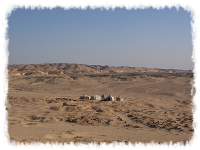
CESRAS Exploration of Deir al-Banat
In 2003, the Centre for Egyptological Studies of the RAS was granted permission by the SCA to carry out archaeological excavations on the site. From 2003 till 2010 nine seasons have been conducted. An area of about 1000 sq.m. with 271 graves and 345 burials was explored in the central part of the Southern necropolis for this period. Thus, the burial density averaging nearly 30 burials per 10x10 square. Many graves contained two or more corpses.
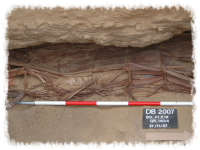
Preliminary conclusions concerning the typologies of the burials were put forth on the basis of the gathered data. Relative and absolute chronologies of the necropolis were worked out. Results of the excavations indicate that the investigated part of the cemetery was occupied during the Greco-Roman and the Byzantine periods.
Graves that have been excavated to the present moment at the Southern necropolis can be divided into two types: niche graves and simple earth graves. Niche graves with one or two niches on the north or south, or both north and south of the entrance pit house the mummified body which is wrapped in linen bandages and adorned with a cartonnage consisting of a mask, a pectoral, a cover on the legs, and a foot-case. The mummy lies in a simple or in a painted anthropoid wooden coffin with the head directed to the west.Another burial custom can be traced in the simple pit graves. The deceased is buried in extended supine position with the head to the west in a narrow pit with rounded corners. Some bodies are laid on palm ribs and wrapped in up to eight layers of thick linen shrouds which are rolled in at the ends of the body, forming two protrusions.Frequently red woolen threads are intertwined with the cloths. Finally, the mummy is tied criss-cross with woolen cords. Sometimes the body does not lie on a palm rib bedding, but rather on an anthropoid wooden board.<br>
Bundles of palm ribs tied together with ropes are also a characteristic feature of some earthen graves. We assume that they were placed vertically when the grave was filled with earth after the funeral. Most probably, they were used to mark the location of the interment.

Beneath the outer layers of coarse linen wrappings several types of clothing (tunics, shawls, scarves, etc.) items often decorated with embroidery and gobelin applications were found. The heads of both male and female mummies were frequently adorned with hairnets or caps. Burials of individuals lying with their heads towards either to the east or the west, wrapped only in one layer of linen shrouds were also found in simple pit graves.

Just few graves excavated in the Southern necropolis yielded pottery. Earrings, rings and bracelets were found only in childrens' interments. Mummies ornamented with cartonnage and gilded masks, painted coffins, and samples of medieval textiles are among the most interesting finds.
Results of anthropological studies shed a new light on the life of the Fayoum’s inhabitants in the Graeco-Roman and the Byzantine periods. They also permit us to advance some hypothesis about possible paleo-demographic, paleo-pathological, paleo-idietological etc. alterations that took place in the region in connection with changing social, religious and political structures.

In 2007 a magnetic survey was carried out at the “Monastery”, and in 2010 a method of prospecting with the aid of radar was tested in the territory of the Northern and Southern necropolises.
Unfortunately we were not able to reveal underground archaeological structures, the upper layers of the site having been seriously damaged by robbers’ diggings. They contain a large quantity of pottery fragments and broken baked bricks that disturbed the operation of our geophysical equipment.
X-raying of a mummy
In 2007-2010 a unique burial with more than 100 naturally mummified bodies of dogs of different age groups was unearthed and studied. The heads of some dogs were wrapped with a ribbon, as if imitating a muzzle. Presently work on processing these data is being conducted. A conclusive publication of the grave is under preparation.
In 2010, excavations were commenced on the territory of the “Monastery” area. The analysis of pottery collected on the territory of this part of the site suggests that this part of the site remaine.
Conservation and restoration of artifacts found in the course of archaeological work (first of all, wooden anthropomorphic coffins discovered in the Roman interments and textiles from Coptic graves) is another important area of the expedition’s activity.
In 2008-2010 a new building intended for storage and the thorough study of anthropological material discovered in the course of the excavations was built and equipped at the site.
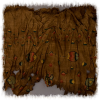
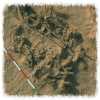
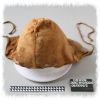

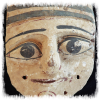
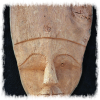
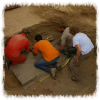


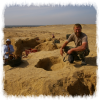



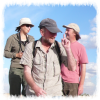

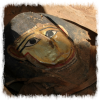
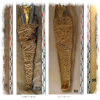
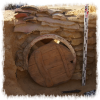
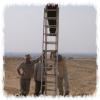
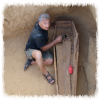
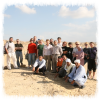
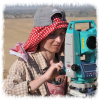
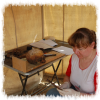


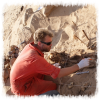
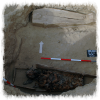
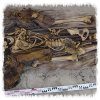
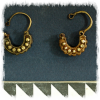

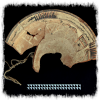
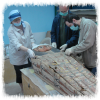
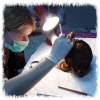
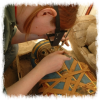
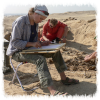
Collaborating Institutions
Supreme Council for Antiquities of AR Egypt:
- Ashraf Senussi (2003);
- Esam Adel Abd El Rahman (2003);
- Mohamed Mohamed Hamedy Ahmed (2006);
- Rania Ahmed el-Said; Zedan Abed el-Sekhem (2007);
- Siham Kamel Abd El Rashid; Amgad Ahmad El Said; Ibrahim Ragab Ahmed (2008);
- Magda Abdalla Gomaa; Iman Ali Mahmud (2009);
- Siham Gamal abd el-Rashid Ahmed (2010).
Institute for Bioarchaeology:
- Walker Roxie
Polish Centre of Mediterranean Archaeology of the University of Warsaw, Research Centre in Cairo:
- Herbich T.;
- Swiech D.
All-Russian Scientific and Restoration Center named after I.E. Grabar:
- Gormatyuk Alexander A.;
- Levykina Tatiana A.;
- Sinitsyna Natalia P.;
- Sinitsyna Helene S.
Institute of Cultural and Natural Heritage named after D.S. Likhachev:
- Orfinskaya Olga V.
The State Research Institute of Restoration:
- Melnichenko Alexey L.
The State Russian Museum:
- Demchenko Marina V.
Institute of Ethnology and Anthropology named after N.N. Miklukho-Maklay of RAS:
- Boruzkaja Svetlana B.;
- Kharlamova Natalia V.;
- Vassiliev Sergei V.
Institute of History, Language and Literature of the Ufa Scientific Center of RAS:
- Nechvoloda Alexei N.
Institute of Archaeology of the Ukrainian National Academy of Sciences. The Crimean Branch:
- Mordvintseva Valentina I.;
- Zaytsev Juriy P.
A.N. Severtsov Institute of Ecology and Evolution of RAS:
- Jachmennikova Anna A.;
- Krylovich Olga A.;
- Pojarkov Dmitrij A.;
- Savinetskiy Arkadiy B.;
- Vasyukov Dmitry D.
Institute of Earth magnetism, ionosphere and radiowaves propagation named after Nikolay Pushkov :
- Kopeykin Vladimir V.;
- Merkulov Sergei V.
Closed corporation "Phenomen":
- Levykina Tatiana A.;
- Popova Olesya S.;
- Sinitsyna Natalia P.;
- Sinitsyna Helene S.
American University in Cairo:
- Ikram S.
CES RAS:
- Belova Galina A.;
- Davydova Alla B.;
- Ivanov Sergei V.;
- Krol Alexei A.;
- Lavrentieva Maria Y.;
- Litvinenko Sergei V.;
- Miroshnikov Ivan J.;
- Tolmacheva Helen G.;
- Voitenko Anton A.
Publications:
- Voytenko A.A. Preliminary report on Coptic Burial Custom at the Necropolis of Deir el-Banat // Achievements and Problems of Modern Egyptology. Proceedings of the International conference held in Moscow, September 29-October 2, 2009. M., 2012. P. 392-400.
- Белова Г.А. Российские ученые в Египте // Белова Г.А. (отв. ред.) Возвращение в Египет: Страницы истории российской египтологии. М.: "Наука", 2009. С. 52-111.
- Васильев С.В., Боруцкая С.Б. Палеоантропология Дейр-эль-Баната (Фаюм, Египет) // Культура Египта и стран Средиземноморья в Древности и Средневековье. Сборник статей, посвященный Т.Н. Савельевой. М., 2009. С. 104-118.
- Васильев С.В., Боруцкая С.Б., Нечвалода А.И. Новые данные по антропологии древних коптов Файюмского оазиса Египта // Научный альманах кафедры антропологии МГУ. Вып. 4. М., 2006, с. 134 -152.
- Васильев С.В., Боруцкая С.Б. Палеоэкология коптского средневекового населения Файюма (Египет) // Научный альманах кафедры антропологии МГУ. Вып. 2. М., 2004, с. 62–81.
- Васильев С.В. Антропологическое исследование раннесредневековых коптов из Файюмского оазиса, Египет (по материалам могильника Вади Наклун) // Интеграция археологических и этнографических исследований. Омск, Изд. Наука-Омск, 2003, с. 273–275.
- Krol A. The RIEC Archaeological and Anthropological Surveys at the Site of Dayr al-Banat // G. Gabra (ed.) Christianity and Monasticism in the Fayoum Oasis. Cairo, 2005, p. 209–216.
